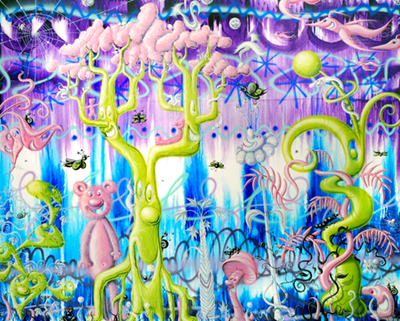
Bear Jungle, 2010 oil, acrylic, and enamel on canvas Courtesy Paul Kasmin Gallery (Click for slideshow)


Last summer, making my way to the entrance of the Laguna Art Museum’s widely popular Art Shack opening, I had to elbow my way past a clump of people standing in line for a taco truck parked at the curb. Past the hungry hipsters, I encountered a second, more excitable line waiting their turn to get into a Pace Arrow motor home, also parked at the curb. I paused for a moment, trying to assimilate the conveyance in front of me with the horde of flashy, Orange County art fans crowding the sidewalks. The RV was nondescript except for a couple of perky looking neon pink faces swooshed on its side. Only when the door swung open was I able to catch a glimpse of its DayGlo interior and psychedelic embellishments, shag carpets and random commodities, all painted and glowing under black lights. The door clicked shut again. I immediately got in line. This acid trip of a trailer was my not-so-subtle introduction to the work of Kenny Scharf.
Only later did I realize that the man behind “Space Arrow” helped pave the way for 1980s street art, rounded out the New York, Basquiat-Haring pop-art trifecta, and has exhibited his work across the country (and world) since 1981. All the while carving himself a nice little niche almost entirely out of playful and fantastic, yet somehow deviant imagery.
(more…)
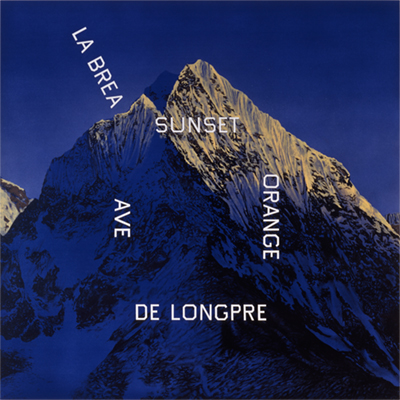
Ed Ruscha La Brea, Sunset, Orange, De Longpre, 1999 (Click to enlarge)

The lure of the open road is a wily temptress. From Jack Kerouac to Bruce Chatwin to
The Motorcycle Diaries, there’s something about life on the road that speaks almost prophetically to the solitary tempers of creative men. Ed Ruscha, one of the most recognizable and profuse artists of our time, is no exception. This week, the Modern Art Museum of Fort Worth opens
Ed Ruscha: Road Tested, a 75-piece personal compendium of the artist’s life (and work) in transit. Conceived by the Modern’s head curator, Michael Auping, the show spans Ruscha’s entire career and every medium as he speeds through no-name towns, past building facades, service stations, signage and all the other random objects that make up the mundane, yet mythical thoroughfares of any American city — creating as he drove, what would eventually become some of the most iconic images of the 20th century.
Auping, who first met Ruscha as a grad student in the early 70s, was kind enough to share his thoughts on why this show is unlike any other Ruscha retrospective you’ve ever seen.
(more…)
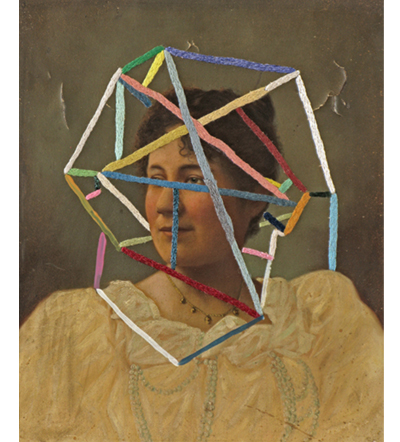
The Accident 2010 Embroidery and acrylic on found portrait

I’ll be honest with you: I’m a sucker for nostalgia in all her shapes and forms. I like cassette tapes and old school label makers. I inhale the pages of dusty books, seek out old family photographs taken in bad lighting, and collect cheesy handwritten postcards from back when postage stamps still had to be licked. Hence, Julie Cockburn — a British artist specializing in altered portraits using found photography, images, and paintings has struck a very deep chord in me. Laying plastic game parts, embroidery, collage and oil paint over each found item, Cockburn’s work confounds typical assemblage. Many of her re-imagined portraits resemble the facets of a gem, or crude impasto finger-paintings rather than actual people. Taking great freedom with each article she finds, Cockburn’s abstract manipulations brand her subjects with new identities and distorted histories — skewing their place in the world while simultaneously rescuing them from the trash bins of obscurity. There’s a playful, yet twisted quality to each fractured subject, caught somewhere between absurdity, forgotten memories and diluted grandeur. Altogether nostalgic and forlorn, Cockburn is also adept at using childhood drawings and kindergarten craft materials like popsicle sticks, stickers, beads, and thread to stirring effect.
Chosen as a selected artist for Britain’s 2010 Marmite Prize for Painting,
Julie Cockburn’s work will be shown as part of their traveling exhibition, ending in May. Two solo shows, both in London — at Matt Roberts Arts and John Jones Project Space are scheduled for later this year.
(more…)
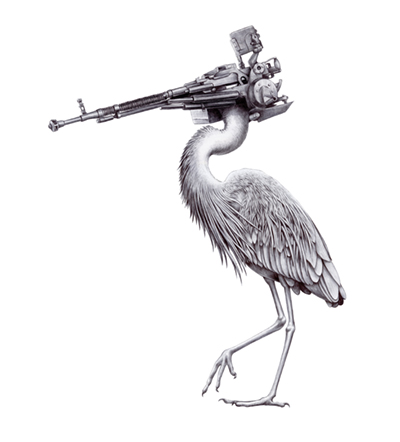
Blackwater (Click to enlarge)

Jesse Hazelip is an artist firmly rooted in the now. Equal parts street and fine artist, the Oakland-based Hazelip has crafted an iconographic language based on global headlines, warfare, and the political monotony of repeated mistakes. His upcoming solo show, Belle of the Brawl, centers on the recent discovery of lithium in Afghanistan and our ongoing occupation of the country. It also demonstrates Hazelip’s ability to infuse the Middle East conflict with a contemporary angle — rare amongst artists of his generation. His work is a provocative, yet painterly call for intellect and revolution, created out of a deep inner need for resolution. Mingling his telltale herons and buffalo with Islamic geometry and scientific renderings, Hazelip’s new paintings reveal a primal relevance rooted in history, politics, and the latent desire to be better human beings. With this show, it’s clear that he’s moving beyond the substrata of modern-day street art, revealing a heightened focus and sharpened point of view that repeatedly begs the question: how are we going to change these patterns? Jesse Hazelip spoke candidly with PLANET about some possible answers to that very question.
(more…)
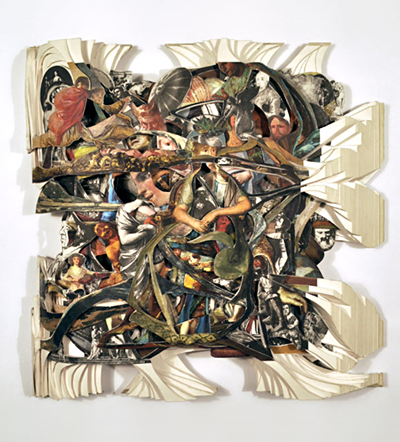
Goya, 2010, Altered Book Image, Courtesy of the Artist and MiTO Gallery (Click to see detail)

For an artist who has worked within the confines of one material for the better part of his career, Brain Dettmer’s artwork has been explained in a variety of clever ways: book autopsies, excavations, conceptual deconstructions, 3D collage. It seems his technique (using surgical tools and knives) and finished products are so unique, nobody really knows what to call it. Taking one of the most recognizable symbols of the Modern Age — books — and reinventing them in a radical, magical, unexpected way, Brian Dettmer’s become something of a sculptor, cartographer, and historian all rolled into one. Much like the surprises a reader experiences with every turn of the page, each hard-cover book sculpture involves a huge degree of happenstance. Once Dettmer seals a book and starts to carve, he has no way of knowing what’s coming next. Dettmer talked to PLANET about knowledge, power, and the tantalizing lure of the future.
Can you begin by talking about your new show, “New Worlds to Conquer”?
I’d been thinking about the quest for knowledge and exploration of the world by adventurers and authors around the beginning of the 20th century — specifically between WWI and WWII — when flight became accessible to an elite few. There was a strong drive to explore the world and share discoveries of these adventures in books. The search for knowledge and exotic places can be a slippery slope though.
(more…)

Final Tiaõ photographic print entitled Marat/Sebastiao–Pictures of Garbage Photograph by Vik Muniz, courtesy of Vik Muniz Studio

Waste Land is a powerful new documentary that follows Brazilian-born artist Vik Muniz to Jardim Gramacho, the world’s largest landfill, located on the outskirts of Rio de Janeiro, to photograph a spirited group of ‘catadores’, pickers of recyclable materials. The catadores eke out a living in the dump, sifting through endless mountains of ripe garbage, removing roughly 200 tons of recyclables a day. Unlikely stewards of the environment, the catadores reside on the fringes of society — in rubbish-strewn slums, ostracized, and misunderstood. Having built a successful art career using unconventional materials, Muniz arrived in Gramacho hoping to “change the lives of a group of people with the same material that they deal with everyday.” The resulting portraits, reconceived on a grand scale by the catadores themselves using hand-picked recyclables, take on a trajectory all their own, reawakening the lives of everyone involved in the collaboration. Directed by Lucy Walker, (Countdown to Zero, Devil’s Playground) and filmed over three years, Waste Land has been lauded with film festival awards, elicited standing ovations from Mexico City to Tokyo, and, along with Muniz’s photographs, helped raise thousands of dollars for the Association of Pickers of Jardim Gramacho (ACAMJG). A film of deep contrasts, Walker imbues the catadores with a sense of dignity and humor, bringing their bleak lives into sharp focus despite the sometimes overwhelming despair of the landfill. PLANET spoke with Vik Muniz and Lucy Walker about junk, the human factor, and the transformative power of art.
(more…)

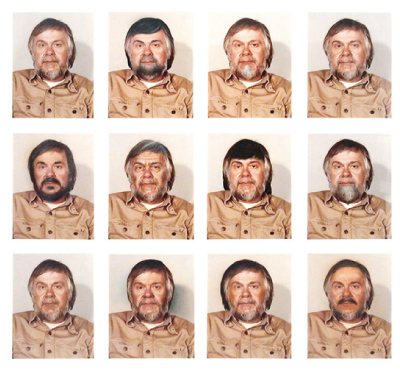
Portrait: (Self) #1 as Control + 11 Alterations by Retouching and Airbrushing, John Baldessari, 1974 (Click images to enlarge)

Painter, teacher, oddball, genius… John Baldessari has defied and surpassed many labels over the course of his career. But above all, nothing seems to fit quite as well as ‘radical’. Considered one of the most influential conceptual artists to come out of the 20th century, Baldessari was bucking the system long before it was cool, and then mundane to do so. A tireless champion of the idea that images and words are interchangeable, Baldessari’s work sought to marry the two entities once and for all. His early paintings earned him a bit of fame that quickly transformed into infamy when he burned nearly everything he’d created between 1953 and 1966 in the dramatically metaphorical, yet very literal, Cremation Project (1970). Baldessari then turned his attention to photography, film, found imagery, and the element of chance to achieve his new world view, drastically changing the way art was made. He hired sign painters and amateur artists to do his bidding, orchestrating elaborate photo series, video projects, and artist’s books such as Throwing Three Balls in the Air to Get a Straight Line. Whenever his interest for a project began to wane, he was off to the next idea— constantly tweaking, modifying and superimposing one philosophy or ideology onto another, looking for answers, challenging perception.
On October 20, John Baldessari: Pure Beauty (on its last leg following stints at the Tate Modern, Museu d’ Contemporani de Barcelona and LACMA) opened at New York’s
Metropolitan Museum of Art. It’s the first major U.S. retrospective of his work in nearly 20 years.
(more…)
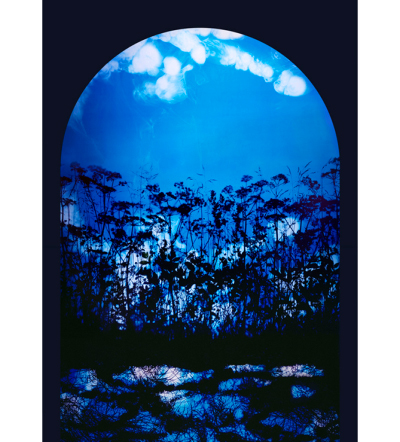
Arch 4 (Summer), Susan Derges Images courtesy of Victoria and Albert Museum (Click images to enlarge)

Made famous by the likes of Man Ray and Moholy-Nagy, camera-less experiments can be traced back to the genesis of photography. Beginning in the 1830s, artists continually broke new ground toying with light-blocking, shadow-casting and chemical manipulation, accidentally creating photogenic drawings, or photograms. Unlike virtually everything we know of today, camera-less images are truly unique and cannot be reproduced the same way twice. Often crafted to scale, the results are ephemeral, transient, and mysterious, offering a more intimate look at the object or figure being captured. Steeped in metaphor and reliant on the ‘unseen’, each image is an exploration — of life and death, time and timelessness, disappearing and emerging. The paradigm of normal perception is questioned as discoveries are made in the shadows.
This month, five leading contemporary artists of camera-less fame will be featured in
Shadow Catchers, a new exhibit opening at London’s
V&A. The exhibition includes an impressive array of enigmatic images that marry the effects of light, movement, science, and art. Eerie silhouettes, spectral forms and magical traces of smoke, air, and water leave the viewer in a perpetual state of suspended disbelief. Five short films and a beautiful hardback book published by Merrell Publishers accompany the exhibit. Together, Pierre Cordier (Belgium), Susan Derges (UK), Adam Fuss (UK/USA), Garry Fabian Miller (UK), and Floris Neusüss (Germany) have done more for the art form than any group of contemporary artists that came before them.
(more…)
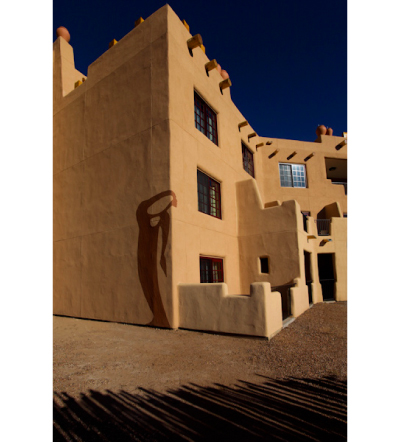
Watchers, Rose B. Simpson. TIME was photographed by award winning, Santa Fe based photographer, Julien McRoberts who is renown for her stunning imagery of the Southwest.

Every now and then, a project comes around that belts you in the brain, creating one of those “aha!” moments we all love but can’t anticipate. TIME stands for Temporary Installations Made for the Environment and has been around since 2005. This year’s exhibition is the first under the direction of fine art consultant and gallery owner Eileen Braziel, and was photographed by award-winning Santa Fe-based photographer Julien McRoberts, renowned for her stunning imagery of the Southwest. The state-driven art project (funded by the New Mexico One Percent for the Arts act as part of the Art in Public Places program) has chosen “Green Technologies/Innovative Ideas or Materials” for its 2010 theme and features everything from a hand-painted tipi and adobe windmills to biodegradable glass bowls and solar-powered lights.
According to Braziel, New Mexico is an ideal setting for the ongoing project. “In New Mexico we understand that the first innovators were the Native Indians and settlers. Solar, wind, and water are the most fundamental elements guiding green technology, and often drive ideas in New Media art installations where artists are using solar panels, LED lights, LED projectors, etc.” Additional materials used in the exhibit include traditional adobe bricks, earth, seed, biodegradable soap and recycled metals from the Los Alamos Laboratory. A barcode located on the plaque of each installation allows viewers to download free information about each artist using their phones, completely eliminating the use of paper.
(more…)

Justin Giarla with one of Skinner's masks

If San Francisco is the renegade city of the art world, Justin Giarla is most definitely captain of the ship. Since first opening the Shooting Gallery in 2003 (in a neighborhood that gently put, is a little shady), he’s become the shining beacon of a city excluded from both the nexus of New York City and the star-studded vault of Los Angeles, a city no longer taken seriously when it comes to fine art. Specializing in urban contemporary and pop surrealism, Giarla’s spreads his expertise between four different art spaces including Gallery Three and the Shooting Gallery’s influential sister gallery, White Walls. Known in local circles as equal parts philanthropist and curator, Giarla’s work outside the galleries speaks at even higher volumes about his commitment to community engagement through the conduit of art. He hosts annual fundraisers for local nonprofits and is closely involved with Hospitality House, an organization that offers facilities and art resources to the homeless free of charge, no questions asked.
Giarla’s newest progeny, 941 Geary will host its inaugural show on September 18 with a circus-inspired “art opera of epic proportions” including real life carnies and interactive games courtesy of Mike Shine. PLANET picks the brain of the man who is single-handedly attempting to reinvigorate the San Francisco art culture by example and sheer force of will.
(more…)

![]()





 Facebook
Facebook Permalink
Permalink Digg
Digg Reddit
Reddit LinkedIn
LinkedIn StumbleUpon
StumbleUpon Tumblr
Tumblr











